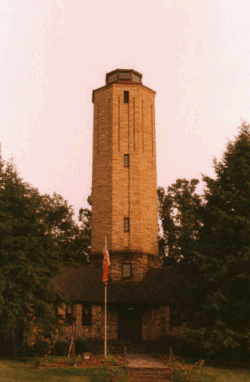 Homestead or "The Homesteads" is an
area about four miles south of Crossville TN. The predominant building
material is a locally mined softly colored sandstone called Crab
Orchard stone. There is a striking, consistent appearance of the
buildings noticeable even to someone not looking for it, and that
appearance is evident in the school and the nearby Cumberland Mountain
State Park.
Homestead or "The Homesteads" is an
area about four miles south of Crossville TN. The predominant building
material is a locally mined softly colored sandstone called Crab
Orchard stone. There is a striking, consistent appearance of the
buildings noticeable even to someone not looking for it, and that
appearance is evident in the school and the nearby Cumberland Mountain
State Park.
Homestead was born in the New Deal under US President Franklin Delano Roosevelt (FDR). The history is fascinating. I urge you to read this story reproduced below as written by Faye C. Newberry and Buddy L. Stinnett. Additional references can be found at the local library with a search of Cumberland Homesteads.
Please note the article below was written years ago and refers to the living museum in the future. It's a done deal. You can visit it now. Check out the Cumberland Homesteads official website for hours and more information.
To view a road map to the area with the Tower (former Administrative Building) marked, click here. (Courtesy of MapQuest)
CUMBERLAND HOMESTEADS PROJECT
by Faye C. Newberry and Buddy L. Stinnett
At the time the whole world was suffering the devastation of the Great Depression, the election of 1932 put Franklin D. Roosevelt into office and allowed him to begin his "New Deal" for America.
One of the first Bills to really impact American society was the National Industrial Recovery Act of 1933. This bill, among other things, created huge public works programs. Tucked away in the recesses of this huge bill, a little noticed section created a very progressive program Subsistence Homestead Communities. This New Deal program was also extremely controversial. Under Section 208, the President was given a $25,000,000.00 revolving loan fund. The plan was to relocate some of the over populated industrial areas to subsistence homestead communities. The Division of Subsistence Homesteads was created to administer this program, under the auspices of the Department of the Interior.
The Cumberland Homesteads was one of the first subsistence projects (Arthurdale, West Virginia, being the first). It was literally a new community, carved from a several thousand acre tract just South of Crossville, Tennessee. The division of Subsistence Homesteads initial purchase was 10,000 acres of second-growth timberland from the Missouri Coal and Land Co. Smaller tracts were also purchased and added several hundred more acres to the first purchase.
Who participated in the benefits of this community? Most of the homesteaders were idle and displaced coal miners, unemployed timber and sawmill workers, down and out factory and mill workers and small time farmers bankrupted by the Depression. They came mostly from the Cumberland Plateau and counties from the surrounding area.
The only way a person could settle on the Homesteads was by Government invitation. Hundreds of people applied, but the stringent government rules kept acceptable numbers low. A committee investigated each applicant (and re-investigated in many cases). Only those who met the rigid standards set up by the Federal Government had a hope of participation in the project. The Government wanted to do everything possible to ensure the success of the project!
The first order of business was clearing the land and building the roads, which provided the first employment opportunities on the Homesteads. As this work progressed, sawmills and kilns were built to process the wood used in construction of the barns and homes. The flooring was most hardwood and the paneling mostly white pine. The exteriors were either hand-quarried Crab Orchard stone or field stone, both plentiful on the tract. Each house had a drilled well from which water was hand pumped to storage tanks in the attic and gravity fed to indoor kitchens and bathrooms – quite unique for the Cumberland Plateau in the 1930's. The homes were wired for electricity during construction because of the establishment of the Tennessee Valley Authority (TVA) to generate power from dams and coal-fired plants. However it was three years before electricity came to the Homesteads.
The bustle of activity on the Homesteads project created a major economic boost to the Cumberland County area. People from the area also found work on the project, in the sawmills, planing mills and in stone quarries. Many of the homesteaders gained valuable on-the-job skills in carpentry, stone masonry, roofing and plumbing. Some followed these endeavors for a lifetime vocation.
Co-operatives were established on the Homesteads. There was a trading post, cannery, loom house, mattress factory and hosiery mill. A medical co-operative was also established. A script system (in place of money) was issued and used on the Cumberland Homesteads. A coal mine was opened and some coal was mined and sold from this endeavor.
The focal points of the project were the school and the Administration Building, which housed offices and a 50,000 gallon water tank enclosed in the tower. The water tank supplied the needs of the Elementary and High School, located adjacent to the Administration building. The school, with its unique individual classroom layout, was the pride of the community. Enlarged through the years, the school today serves grades K-8 and has over 800 children enrolled. The Tower building (former Administration Building) now houses the Cumberland Homesteads Tower Association (CHTA) Museum.
The Cumberland Homesteads was an ongoing federal project from 1934-1946. Begun by the Division of Subsistence (1933), it also was administered by the Federal Emergency Relief Administration (1934), the Resettlement Administration (1936), The Farm Security Administration (1938), and the Farmers Home Administration (1946-1947).
World War II ended the depression. At this time the Federal Government began divesting its interest in the Resettlement projects. At this time, the Homesteaders were finally allowed to purchase their farms. They had come to the Homesteads on a rental-lease system. The homes were purchased on low interest, long term notes.
In the late 1970's, a group of concerned citizens from the Homesteads community conceived the idea of forming a community group to help save the Cumberland Homesteads Tower Building from neglect.
On July 25, 1980, the Association was granted a charter from the Tennessee Secretary of State, thereby certifying that the CHTA, Inc. is a recognized Corporation with the State of Tennessee. The purposes of the Association were and still are: 1) to preserve the Historic Cumberland Homesteads Tower which housed the Administrative offices and the water tank which supplied that building and the school with water. 2) To complete a Museum within the tower structure to tell visitors the history of the Cumberland Homesteads and of the construction of the tower building. 3) To conduct all business of the Corporation which is not inconsistent with the laws of the State of Tennessee.
On August 8, 1988, the United States Department of the Interior and the Tennessee Historic Commission placed the Tower Building (Administration Offices), the Community School, and the remaining 218 original homes on the National Register of Historic Places. The whole community was recognized as a National Historic District and was also placed on the National Register of Historic places.
On September 5, 1990, the United States Department of Treasury granted the Tower Association 501(c)(3) Tax Exempt status with the Internal Revenue Service, thereby qualifying the CHTA as a non-profit organization.
The Cumberland Homesteads of 1998 bears little resemblance to its 1947 counterpart. Most of the surviving 218 homes have been extensively remodeled. The Homesteads was then, and still is today, one of the most desirable areas of Cumberland County. Consequently, land values have risen quickly in recent years. There are several homesteads houses on the market today in the $175,000 to $300,000 range. Few farms remain with their original acreage. Subdivisions have developed, fine modern homes are abundant and people from many sections of the country are relocating to the once spacious area.
The Homesteads Tower Museum entertains 10,000 visitors yearly. There are usually 15-20 countries represented from international travelers. One of the most frequently asked questions is "Can we go through one of the Homesteads houses"?
The CHTA has now obtained a Homesteads house close to the Tower Museum Complex. We are now in the process of restoring it to original condition. We hope to establish a "Living Museum" to show our visitors just how life was on the Cumberland Homesteads in the 1930's and 1940's. We feel this will be a great educational tool for our community, county and State.
The property we purchased is ideally located for easy access from the Tower Museum. It is located two miles from the Museum and 0.8 mile from the Cumberland Mountain State Park on State Highway 419 (Pigeon Ridge Road). There has been little done in the form of remodeling, etc. This alone will make the restoration project less costly and more feasible.
All bathroom and kitchen fixtures will be original. The Museum is in possession of several pieces of furniture made on the Homesteads, such as dining table, chairs, bed and mattress, etc., all of which will be used to furnish the house. The exterior, which is quarried stone, will not require any changes.
Plans are to construct a barn, according to the original plans. We would have a family actually living and working the homestead.
The barn, which the original families lived in while the houses were built, will be used to store the farm equipment and also house the animals.
There will be a garden and vegetables will be canned or preserved in the same manner as the original families did.
A fee, which will be used for maintenance and improvements, will be charged for touring the "Living Museum". This project is intended to be one of the major tourist attractions in the Upper Cumberland Region. And, in addition to the tourist, the close proximity to the several schools in our area, it will provide an important learning tool for all the children in this area and surrounding counties.
